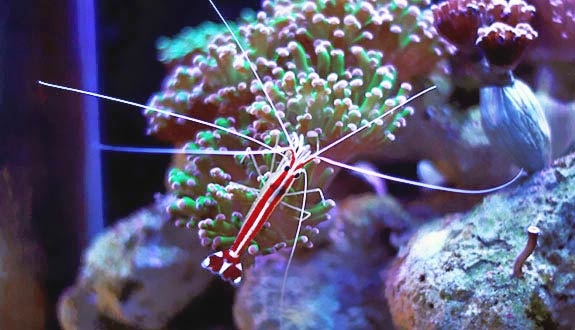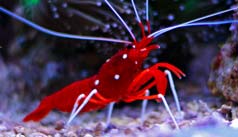

Alternative species (click on the thumbnail to see the card)
Names
Scientific name
Lysmata Amboinensis
Common name
Skunk cleaner shrimp
Pacific cleaner shrimp
Amboin cleaner shrimp
Peppermit shrimp
Scarlet cleaner shrimp
Origin

Origin: South Pacific and Indian Ocean, Red Sea
Biotope: None
Dimorphism

None
Group
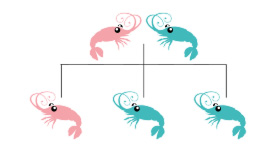
Hippolytidae
Volume

100 L / 22 imp gal / 26 US gal
Parameters

T°: 24 à 27°C or 75 to 81°F
pH: 7.5 to 8.5
Density: 1021 to 1024
Difficulty

Easy
Size
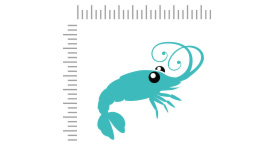
6 to 7 cm (2.4 to 2.8")
Longevity
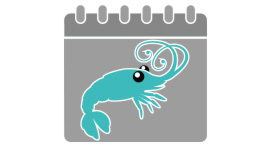
5 to 7 years
Living zone

Everywhere
Individuals
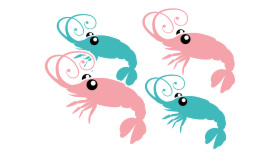
2
Food
How to feed the Lysmata?
Food
How to feed the Lysmata?
This shrimp is omnivorous with a carnivorous tendency, detritivorous and also deworms the other fish.
It consumes fish food residues (and will be a valuable aid in the maintenance of the aquarium).
However, stay tuned for its needs: if it runs out of food, it could harass your fish for pests. Do not hesitate to supplement its diet and satiate its carnivorous appetite.
Behavior
What kind of behavior does the Palette Lysmata have?
Behavior
What kind of behavior does the Lysmata have?
The Amboin cleaner shrimp shrimp will make a perfect inhabitant for your reef aquarium. Peaceful, it spends most of its time away from rocks.
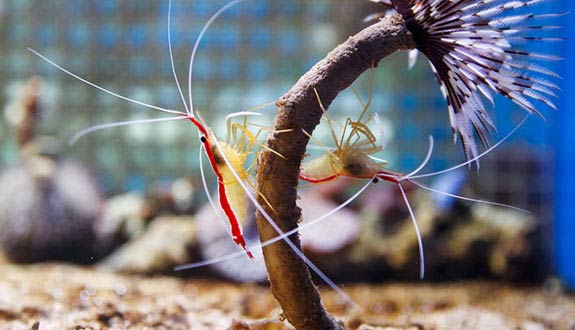
Sociable, it will appreciate the presence of its congeners (it was observed that shrimp alone lived less than those kept in groups). In general, they are found in pairs in most aquariums. Indeed, the hierarchy beyond 2 individuals can be difficult to establish. This couple will be very united after a few weeks.
This shrimp will moult throughout its life. In good conditions, moulting occurs about every three weeks. Beware of the over-dosage of iodine, which can be detrimental: a too important approximation of moults weakens the shrimps and decreases their life expectancy.
Not shy, it can even pick up its meal directly in your hand, also taking the opportunity to make a small scrub!
Cohabitation
Who can live with the Lysmata?
Cohabitation
Who can live with the Lysmata?
No particular restriction of cohabitation is to report, quite the contrary! It is a great ally for your fish: by installing a «cleaning station», it rids them of their parasites (skin, hearing, teeth...). This is called symbiosis (a sustainable and mutually beneficial biological association between two living organisms). We are always impressed to see how some big fish approach, open their mouths, and let the shrimp clean their teeth!
Breeding
How to breed the Lysmata?
Breeding
How to breed the Lysmata?
The breeding of this shrimp is possible for the experts.
Lysmata seem to be hermaphrodite, that is to say that each individual has the possibility to be both male and female. If you want to start breeding, you will still need two individuals.
They are also protandrous. It simply means that all these shrimp are born male, then become female according to the configuration of the population already in place and breeding needs.
A female can lay between 200 and 500 eggs during the same spawning. It keeps them under its abdomen (between its pleopods) all the time of the incubation. They will take about 20 days to hatch (variable depending on the temperature). The eggs are green, then turn yellow / orange at the end of incubation.
The larvae are only 2/3 mm or 0.07/0.12 inch at birth. Because of this small size, they are difficult to feed. You will need very finely chop mussels, shrimp, squid... Give several small meals a day.
Larvae grow in successive moults every 3 to 8 weeks.
Little trick: the young shrimp are photophilous, that is to say that they are attracted by the light. To catch them, simply turn off the lighting of your aquarium and illuminate only a small part, for example using a flashlight. All the small larvae will approach, then you just have to siphon.
Source: http://aquariusite.free.fr
Its aquarium
Which aquarium for the Lysmata?
Its aquarium
Which aquarium for the Lysmata?
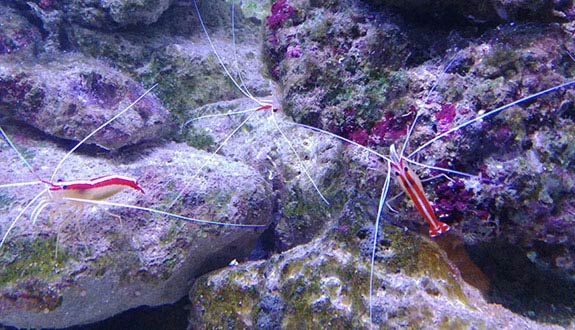
This shrimp likes dark places. Set in your rocky setting many crevices and hiding places for its comfort. Also attach invertebrates such as anemones or corals.
Good To know
Find all additional information!
Good To know
Find all additional information!
Often confused with Lysmata Grabhami. We can differentiate them by the drawing of the tail. With the Lysmata Amboinensis, the central white band stops before the tail, while with the Lysmata Grabhani, this band extends to the end of the caudal fin:
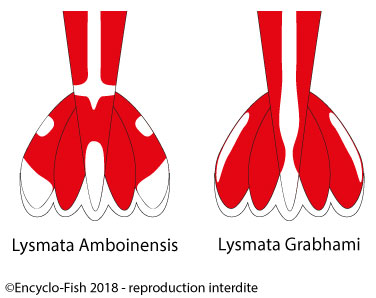
This shrimp is very sensitive to variations in pH and salinity. Acclimate it slowly and gently! In addition, too high a temperature is poorly supported in the long term and decreases the life expectancy.
It owes its name « cleaner shrimp » to its ability to clean and de-worm.
This shrimp is part of the family of decapods: they have 5 pairs of legs, and therefore 10 feet.
Yours photos!

By Encyclo-Caro

By Encyclo-Caro
Comments
Sort by:
Please login to post comments
